#THIS IS ABOUT THE MISINTERPRETATION OF THE WAR
Explore tagged Tumblr posts
Text
wow this show really goes out of its way to show the audience that Paddy is gay and deeply in love with Eoin and damaged irreparably by his passing (as opposed to explicitly telling us, i imagine to give them plausible deniability when they’re accused of defaming recently deceased, celebrated war heroes beloved by uptight conservative military historians). and they do it consistently, from episode to episode, even having Eoin haunt the narrative long after he has died - but so much of the heterosexual audience on non-Tumblr social media will say either they didn’t “get that vibe at all” or that there’s no reason to assume it was more than friendship.
like putting my gay indignation aside completely, how dense and cinema illiterate do you have to be to completely miss or misinterpret established run-of-the-mill cinematic techniques meant to convey romantic attachment or attraction? in regards to the cinematography and visual/audio storytelling, what could possibly surpass the depiction of romance as the filmmakers’ primary objective when they chose to zoom in on Paddy’s hand resting on Eoin and then leave the camera there for a long and intimate moment as they play a famously longing, romantic composition together on the piano, looking emotionally and physically insular and private despite the presence of the other men around the hall? the men, whose raucous banter has been muted. in a scene that would otherwise serve no purpose to the narrative (actually, it laid the foundation for a frequently revisited metaphor symbolizing Paddy’s inability to move on and desperation to feel a connection to Eoin again).
and then to repeat the touch/camera zoom technique again, in the very next episode! in a deeply romantic moment where Eoin makes it clear that his direction in life is entirely dictated by Paddy and where Paddy goes. we don’t get the impression that they have ever made the nature of their love explicitly clear to each other; we do, however, get the impression that they are life partners and soul mates who are mutually aware that they’ve dedicated themselves to each other. maintaining their relationship in this way might be the most practical method in their current circumstances - their relationship is physically unconsummated, but they have figured out how to maintain each other in their day-to-day lives in an emotionally consummate way that doesn’t risk the notice of those with the capacity to punish, hurt, and separate them, and restrict their freedom.
okay now reeling the gay indignation back in, the straight viewers who argue that there is nothing inherently romantic about a hand on a shoulder/that not showing anything more explicit means that “the writers are leaving it up to the audience” to decide if it’s friendship or romance are dicks for refusing to consider it within context or even ask why a romantic attachment might manifest itself in such brief and seemingly trivial touches.
what types of touches do they genuinely think would occur between two men harboring romantic affection for each other, when the entire lives of those two men are spent in a hyper-macho, violent environment that is hostile towards sentimentality, and legally and socially punitive of homosexuality? in their current circumstances they are unable to achieve the safety that would be afforded to them by a genuinely private physical space where they could be transparent about their feelings and motivations. they are never alone, so they enact touches in ways that would be perceived as commonplace camaraderie by an observer who doesn’t know to look closer, and literally speaking that is what is happening. meanwhile, the actors are tasked with the feat of minutely conveying a longing that the characters have kept hidden even from each other in the interest of self-preservation and preservation of the other; but the actors have to be even subtler than subtle, so that it doesn’t become unrealistic or compromising to the characters given the precariousness of their situation.
with those limitations always in place, it becomes necessary for the camerawork and music choices to convey that meaning for the audience in ways that the characters literally cannot. you need to give this touch between them its due attention, and consider the emotions that informed it and resulted from it: longing, desire, tenderness, pleasure and comfort in each other’s presence, revitalization. hopefully from there the viewer could surmise that Eoin and Paddy have adapted common rituals to their own needs in order to satiate a hunger inside them that (most of) the other men don’t have.
e.g.,
insisting that he let me teach him to play the piano will put him in close proximity again and again, and when he leans over and around me i can try to feel the warmth of his body hanging close, and sometimes i might even get to feel the direct heat of a hand placed on my shoulder. / he’s teaching me to play but i’ll hover with my drink over the piano and him below me, so that when it comes time for me to repeat his movements, i might be able to lean in close enough that i can discern the pattern of his breathing or the smell of his hair / when i touch him, he never looks me in the eye, but it doesn’t upset me, because i can feel how deeply the rest of his body welcomes it. it thrills me to know that there’s no other person on this earth that he would permit to touch him like this. / if i perform this drill remarkably or outlandishly enough, the men will clap and holler and i know then Eoin will come and put his arm around my shoulder, and an arm around the shoulder is nearly an embrace.
68 notes
·
View notes
Text
like i get where the misinterpretation would happen but i don't think hawkeye hides his feelings with humor. i think he's perfectly candid about his opinions on the war and anyone who supports it. i mean, at the end of his yankee doodle doctor reshoot, he talks directly to the camera about how war isn't a movie, and then makes sure the visiting general watches that clip. he tells that interviewer that he makes jokes to get reactions (i.e. lift people's spirits); he doesn't deny why he feels the need to do so, and in fact he goes on to describe the experience of waking up terrified in the middle of the night with your heart pounding (really, the entirety of the interview is the best display of how incredibly open and honest hawkeye is). he was the one who said that war is war and hell is hell and war is so much worse.
he will get anyone's attention, and by any means necessary, to tell them directly to their fucking face how much he hates being here and hates what war does to people. if he's dishonest, it's to trick people, and if he's tricking people, it's to save lives and/or fuck with anyone who'd allow lives to be lost.
taking him at face value as a hehe haha jokester is so superficial that even frank and flagg don't do it; even they recognize hawkeye as a powerful source of dissent and rebellion within the unit that must be beaten into submission before his ideas spread.
80 notes
·
View notes
Text
hey guysss! i got a little worried because i saw some things about chris wearing a shirt with a nazi symbol with it, so i did as much research as I could to make sure I know who im supporting!!
for context, this is the shirt:

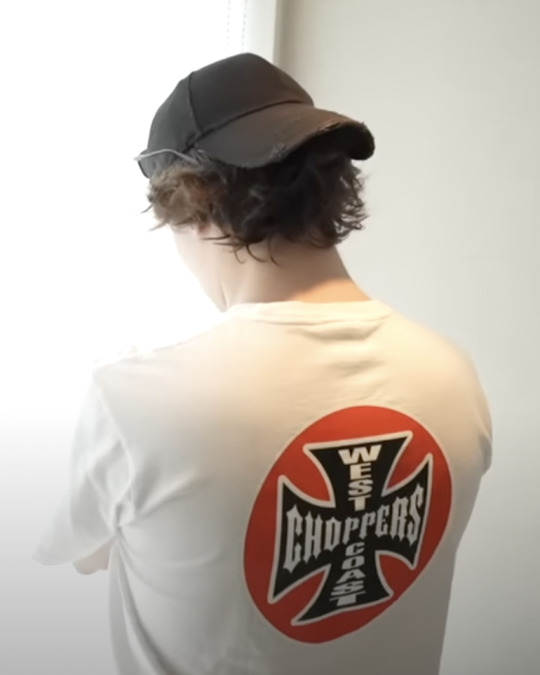

it is of the popular brand "west coast choppers"
it is a motorcycle brand started in the 1990. It is all about custom bikes, biker culture, and selling gear, ect
their logo is shaped like an iron cross, which some people confuse with nazi imagery.
history on the iron cross:
the iron cross symbol has been around for centuries in Europe.
It started with medieval knights like the teutonic order
In the early 1800s, the kingdom of prussia turned it into a military medal.
It was used by the german military through the 1800s and World War I, long before the nazis existed.
The nazis did use a version of it, but they added a swastika in the middle. That version is what is specifically nazi.
y bikers use it:
after ww2, some american bikers used the iron cross to look rebellious and anti-mainstream.
It was a way to stand out and say they did not follow society’s rules, not to support nazis.
the creator of the brand has stated repeatedly that the iron cross is not in relation to nazism
now lets be honest, chris was not thinking about all this when he bought the shirt, but that doesnt mean we cant
my conclusion is that chris wearing that shirt just means he likes the design or the biker vibe. It is not supporting anything hateful.
PLEASE PLEASE dm me to tell me if i am either incorrect in my research, missed something, misinterpreted something, etc.
of course you can come to your own conclusions based on the historical facts, but make sure you do research.
#sturniolo#the sturniolo triplets#sturniolo triplets#chris sturniolo edit#matt sturniolo#chris sturniolo#christopher sturniolo#matthew sturniolo#sturniolo edit#sturniolo fandom#sturniolo fluff#sturniolo imagine#sturniolo fanfic#sturniolo smut#nick sturniolo#nicolas sturniolo#sturniolo tumblr#sturniolo x reader
55 notes
·
View notes
Text
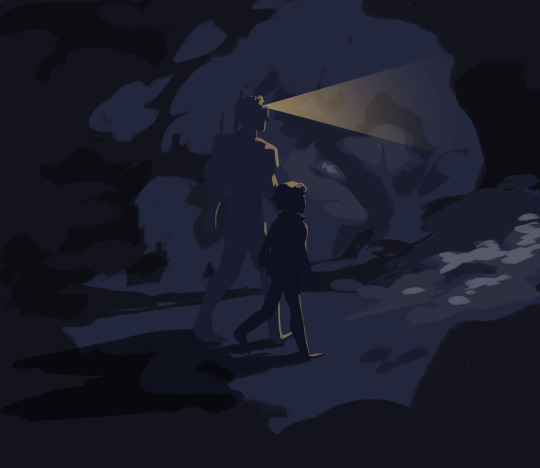
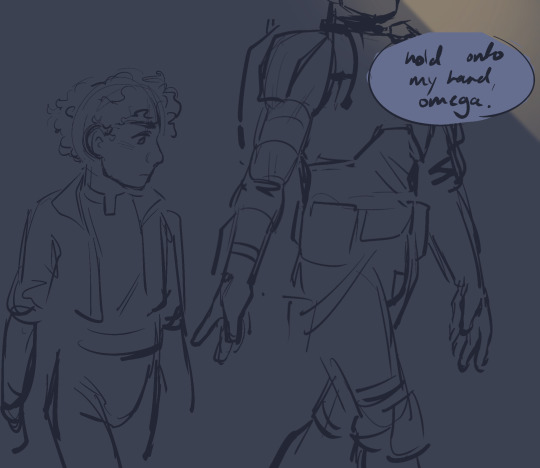
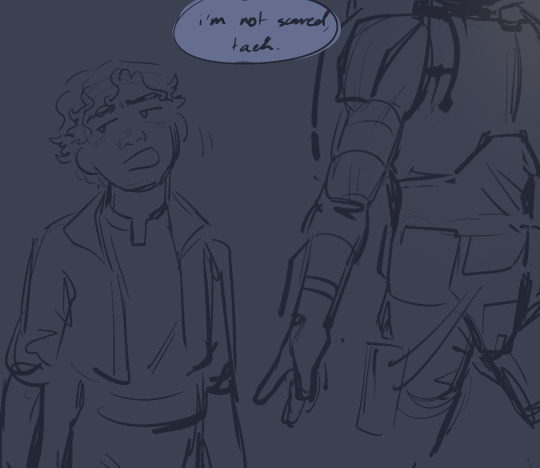
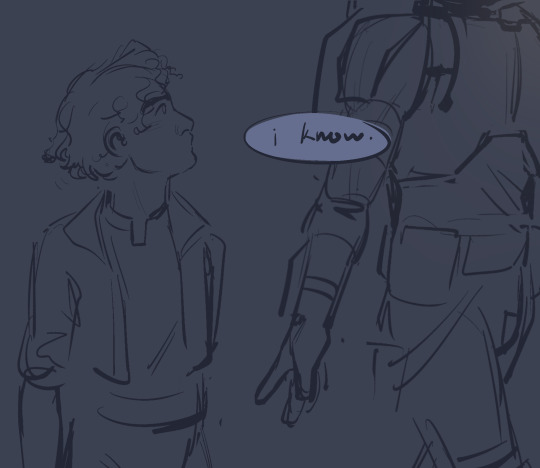
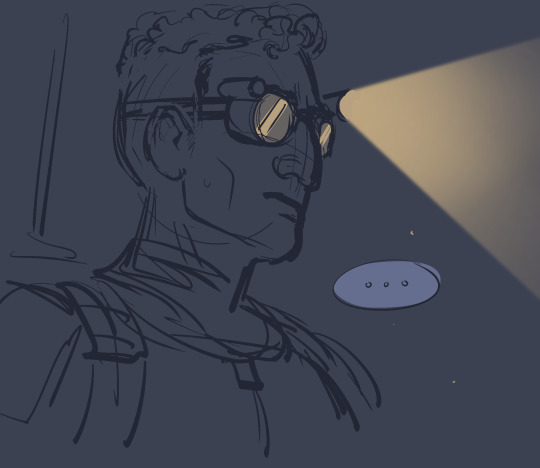
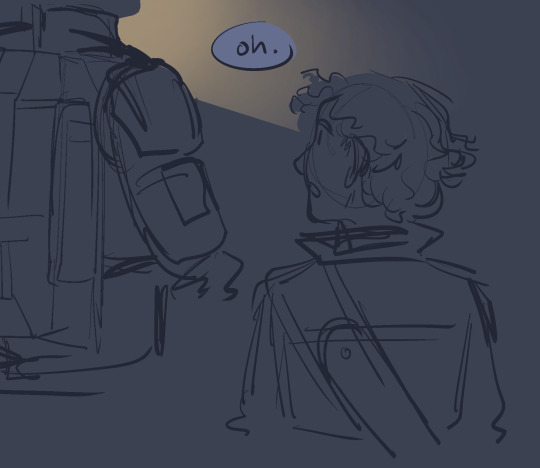
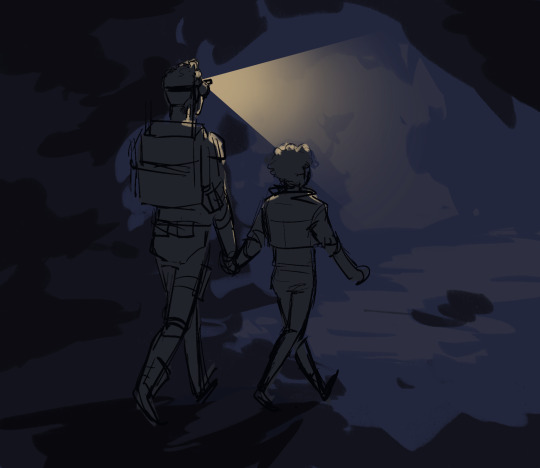
little scrapped comic bc it felt a bit ooc to me in hindsight
#tbb#the bad batch#the bad batch season 2#the bad batch season 3#tbb tech#tbb omega#i was worried that this wouldn’t really come across as i intended#i’ve heard a lot of people complain about the characterization of tech in fanon#they make him a lot less capable than he is in canon just because he is the ‘nerd’ of the team#which i totally agree with#so i didn’t want it to seem like i was doing the same#i just think that tech would have a difficultly expressing some of his vulnerability around his brothers because they are so often stoic#(and frequently make fun of one another)#and omega might be the first person he feels comfortable in letting that side of him show#idk#just a sweet idea to me#anyway i decided i wasn’t going to finish this because of my fear of being misinterpreted but i did like how these sketches turned out#so here :)#a little treat#mods art#my art#mods draws#star wars#sw tbb#star wars the bad batch
1K notes
·
View notes
Text
The attack on Iran is not just Israel's fault, it's also islamic republic's fault. Governments and regimes acting only on their own self-interest, putting on displays, initiating attacks and then getting revenge and doing counterattacks as if all they want is to not be outdone by the other, AS IF INNOCENT PEOPLE AND CIVILIANS DO NOT EXIST IN THE EQUATION! This is our dictator regime's fault as much as it is Israel's (I'm not even going to get into Israel's role in this and its sheer audacity, what's obvious doesn't need pointing out.) Persians have rebelled against the IR regime again and again, calling them out on their acts of terrorism and their meddling in neighboring countries' affairs, and they got killed as a result. Iranians are not mad about the political and military figureheads that were killed, No. They are mad that their government's reckless and selfish actions have led to THIS, to getting bombed at 3 in the morning, innocent people suffering. We are scared and angry because when this leads to war, leaders and presidents and prime ministers and such are not the ones that will suffer. They can hide and run away and be protected at anytime. It's the ordinary people, innocent people, that will get caught in the crossfire.
So do not mistake us Iranians' rage and fear of these attacks as being sympathetic to the regime. No. We want them gone and you'd know that if you've been following the protests that had happened and have been happening. But we also don't want a war to wreck an already broken country and a people that are already being killed in their own land by their own leaders.
#This is NOT a religious war. This is not Judaism vs Islam. It's not!#Stop misinterpreting the obvious fight for power as something religious. Stop distracting people by making it about religion#it's not about religion#if you want to help overthrow the regime then help but not by destroying our home and at the cost of people's lives and their sanity#and btw you aren't fooling anyone we know your intention is maintaining the good old power and not the wellbeing of the people#but if you think you can use us and our righteous anger to your own advantage well we CAN and WILL definitely use you too#iran news#iran#israel#war#middle east
94 notes
·
View notes
Text
*takes a deep breath* No but you see, there is no conflict between "Do or do not. There is no try." and "Remember this. Try." They're both getting at the same thing, just from different angles. Yoda tells Luke the former because Luke thinks the training is too difficult, that he's been trying and he still can't do it so he'll never be able to do it. What Yoda is saying is that there's no such thing as a halfway attempt. He's not saying "Succeed in doing this or fail, there is no in-between," he's teaching Luke that you don't start doing something and then just drop it when the effort becomes too much. You do it, even if you fail, or you don't do it. Meanwhile Nemik's manifesto is saying the same thing - no matter how impossible something might seem, it's better to try, you have to try. Both characters are exhorting others to step up and do something, even when it's difficult, especially when it's difficult. There is no dipping in and out, maybe I'll try it out a little and then when it gets too hard or unpleasant, I'll give up and move on to something else. Do not give into despair. The road is not easy and you do not know what lies at the end of it and you may not succeed, you may never succeed, but you must make up your mind and commit to taking it nonetheless. Do it. Make the attempt. Try.
#star wars#andor#i have so many thoughts about how much yoda is misunderstood by everyone (including sometimes the writers) and scapegoated for everything#to the point that everything he says and does is twisted and misinterpreted to be 'emblematic of everything wrong with the OLD jedi order'
421 notes
·
View notes
Text
"i hate how viktor is the main bad guy because he's disabled" "jayce wasn't forced to die with viktor" "if you think mel is manipulative you didn't get the story" but MULTIPLE things can be true at once. arcane is a story about political and subsequently historical forces that shape decisions of the people that exist in the moment, AND vice versa. it is also about how decisons are made by people shaped by political contexts. arcane is about good people coming face to face with difficult and controversial situations.
it is about viktor being worn down to the bone looking for a cure and a relief and turning to last resort because the world is cruel, ending up making it even more that way. it is about jayce being privileged and guilty, eternally guilty for never being able to see viktor fully equal to himself despite immense love for him. it is about mel employing her power in the most genuine and empathetic way she knows of. vi, jinx, even cait are products of environment. that's what it's about.
it is also obvioisly about love. but to say that the ending was bad because mentally and physically ill characters died is, i feel, disingenious. sometimes people fail when they are facing history. sometimes it just matters that love was there. sometimes a story is not about individuals, but about external forces. arcane is that story.
#arcane#jayvik#I AM AT MY LIMIT! (im very much not)#im thinking a lot of thoughts today and it just is always baffling how many people misinterpret it and twist it#like. i mean. I MEANNNN YEAHHH OKAYYY you can read it that pessimistic way. sure. but you cant say its the exclusively correct reading!!!!#and whine about how something better wasnt delivered because IT WAS!! because its NOT what the story is about#unironically arcane is modern war and peace and a lot of yall would fail grade 10 literature class in russia#mine#HELLOOOO im insane about jayce specifically btw
24 notes
·
View notes
Text
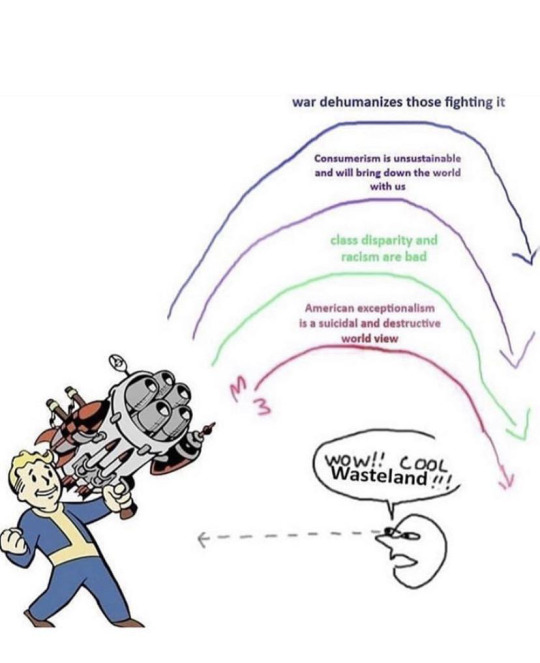
this image is so funny lol. half of these themes are not in the games.
#look at the state of my fandom dawg half the audience is mocking the other half for ‘’misinterpreting’’ themes they made up in their heads#the bottom two are the closest to being substantiated by the text#with love and peace the first two are fanon#the games are definitely anti war but there’s nothing about dehumanising those fighting it idk what that’s supposed to be about#and i think we’ve exhausted my opinion on fallout’s interest in consumerism on this blog so i’ll just stop there#fallout
25 notes
·
View notes
Text
bsd fandom has always mischaracterised kunikida to hell and back but the fact that i am seeing SO MUCH hate for his character right after his 'death' is insane
#'kunikida is a boring character' 'dazai doesnt even like kunikida' 'kunikida has never suffered through trauma' DO U HEAR YOURSELF...#on one hand yeah studio bones butchering ln1 so bad will always be a main source of the misinterpretations#but EVEN THENNN you dont HAVE to read ln1 to get it. you just need to use your brain!!!!!#i dont care if you dislike kunikida or dislike knkdz or whatever. you can have your own opinion#but dont make up bullshit reasons for why you dont like them??????#and also ship wars are so stupid if i see ONE MORE POST comparing skk and knkdz's partnerships#which while have some good parallels#are ultimately not the same#then i will FIND YOU#skk and knkdz involve dazai in two very different stages of his life and you cant compare them#'oh this is healthier. oh this is more interesting. oh this partnership carries more weight. oh--' SHUT THE FUCK UP FOR FIVE SECONDS#LET PEOPLE LIVEEEEE#sorry for being petty but ive gone seven years without a knkdz manga interaction and so many skk shippers still wanna whine about how their#ship is better or whatever. like you already own so much content. so much of the fandom is skk tunnel visioned#why are you threatened by other shippers just having fun. calm the fuck DOWN#and also STOP PUTTING YOUR BASELESS HATE IN THE KNKDZ TAG I DONT WANNA SEE ITTTT#tag it as anti or whatever but dont shove your hate into the ship tag lol thats just basic etiquette#ok sorry im done now goodbye#this went from being annoyed at bad knkd takes to stupid knkdz hate but. those always seem to come together#smiles through the pain#bsd spoilers#sorry forgor to tag that
62 notes
·
View notes
Text
When they troll so hard they end up trolling themselves.
And no, this is NOT an admission that they are a couple.
#YinWar#WarYin#Memtem#waiting for that part in particular to be misinterpreted in 3....2.....1#War Wanarat#Yin Anan#I'm just laughing about them#also kind of brilliant posting this before a 24 hour flight so they won't have to see the aftermath
9 notes
·
View notes
Text
truly i do think people can write and read ooc stuff i do i dooo but it is hilarious to me when its like 'we can do what we want!!' and yet every rec list where someone is SPECIFICALLY asking for non ooc stuff is filled w the fandom favourite fanon stuff. like interpretive differences are one thing but when u have zero basis in canon you gottaaaa recognise ur dealing in fanon. its OKAY if you like fanon!!! but like. please be aware of urself bc i dont think you recognise youve failed to understand the text😭😭
#and just bc a fic has the opposite of the usual dynamic (ie. the infantilised bottom assigned instead gets dom top assigned) that does nawt#mean that uve escaped fanon#ur just in the opposite trench of the fanon wars baby <\3#ANYWAY. i just. fanon is okay fandom will fandom but i think the like. guns out defences of it when we are talking about people#misinterpreting canon is disingenuous. like do you just enjoy that fanon dynamic or have you genuinely not noticed it wasnt canon accurate#until someone pointed it out and now ur falling on an easy defence instead of considering why you didnt actually understand the character.#etcetc#if u like fanon then go ahead and like fanon but KNOW in ur heart that it is fanon it is ooc. pls.#in cases where i like canon rejection its always been the case that to beat reject canon you have to Understand that canon#and a lot of people dont😔😔
10 notes
·
View notes
Text
Was Feanor right to burn the ships?
Ok, first of all, the title is a clickbait! Second of all, uhhhh... it's not a clickbait? Let me explain.
I only read Silmarillion and it was some time ago, but bear with me. Ships are ships, right? I mean, they are used to travel the sea. They have Function, they are USEFUL. So... why are they described the same as Silmarils? The bright jewels which I definitely saw described as mathoms in few posts, and as rocks in literary every post about them? It was because they were as precious to Teleri as Silmarils were to Feanor/Noldor, it was cultural treasure, YES, we all got that part. And if we got that part, then Feanor The Greatest Noldo That Existed and an artisan himself would get the comparision and slow down on being a Bitch. But actually, no? He doubled down so hard he murdered people about it? And not only that, when he used the ships he burned them? The treasures comparable to Silmarils who he very notably was ready to fuck two whole continents over? Why??????? Let's take politics, practical issues and Feanor descent into madness aside, and focus on Feanor the Craftman. What would Feanor, The Crafty One, think about ships? Canonically, he saw them as means to get from point A to point B. Huh. How boring. But... that's what boat is for? "A ship in harbor is safe, but that is not what ships are built for." Feanor would see it that way. And he definitely saw them as valuable. After deciding he was done using them (euphemism in this case) he would... what, keep the ships in harbor. Staying there. Where they would be unused once again (or be stolen, like 'gasp' Silmarils). (let's remember that to Feanor all Valars were enemies at this point. Yes, Morgoth could steal the ships at his end, but in Valinor so could the Valar - stolen from Fingolfin's nose, yes, but there was no guarantee ships would just be returned to Teleri. They could very much be confiscated for safe-keeping. Again, Silmarils come to mind). Yes, it was better to burn them after using them instead of letting them be pretty and rot unused, or be stolen.
#silm#silmarillion#feanor#swan ships#I opened silmarillion mid-post and apparently those were just... normal ships? but pretty?#as in they were used and made by Teleri#why did I think they were gift from Ulmo to Teleri to help cross to Aman? like no they got there on a moving island#it's scary how big the gaps in ones memory can be#but in this case why the fuck didn't Cirdan build them ships and send them to Aman he did that in later ages#no wait they did send ships Turgon commisioned them#but all ships sinked#I think it's safe to say it was because Valar were mad at Noldor#in this case there were no sense in sending ships back as they would drown too#once again Feanor was right#damn I made myself mad#not on the topic but I love headcannoning Silmarils as you know useful#like. bitch you thought we went to war over useless rocks? SIKE super extra computer running on Treelight#Feanor Would and then wouldn't tell anyone about it#because he's That Bitch#I am Feanor Apologist and it shows#that's not The Point of the story The Point is Hubris but eh it's my delusions and I choose the Misinterpretation#I really thought I was cooking something here but no. normal boats
3 notes
·
View notes
Note
i don't think people hcing charlie as transfem are trying to dismiss the transmasc charlie hc! i think it's more of a projection thing for a lot of people, since i know at least a few of the main people who enjoy the headcanon are transfem themselves!! i don't think you have much to worry about in terms of people dismissing the tmasc or other genderqueer charlie hc anyways, since it's already much more popular! i think you're perhaps being a bit too critical.
I've literally never said anything like this at all, I think you've either misinterpreted something else I've said or have the wrong blog.
All of my Charlie gender-based posts or reblogs I've stated/tagged that I think any interpretation of Charlie's gender can make sense, be it transmasculine, transfeminine, nonbinary, agender, whatever you want.
I am one of the ~3 blogs that has access to The Bathroom Problem script and who posted and pointed out that you can make out/slightly hear the Joyce cuts in the episode itself. I would not have excitedly shared that for open-interpretation if I was "worried" people are "dismissing" transmasc Charlie headcanons. (Which, again, I've literally never said, but in any case, I believe it's valid for anyone to dismiss a headcanon they don't agree with, fandom is a sandbox.)
What I personally don't care for are genderbends and, almost by extension, analysis/meta on canon scenes that rename/re-gender the characters with no basis (or, one that comes off wrong). Both topics I've literally never publicly spoken out against here, nor have I said anything bad/negative to everyone who personally enjoys these things, so there is no way for me to possibly be "too critical" in that regard. I keep most of my opinions to myself and my close mutuals, almost exactly for what you're saying: I personally don't want to harsh or dismiss anyone's headcanons.
I have never said, and have never meant to imply, that anyone interpreting Charlie as transfem is attempting to dismiss anyone else's headcanon (which again would be a non issue to me anyway).
#if youre coming here from a certain twitter post#which#mind you was a 3 deep reply to one specific mutual. aka not a public criticism#i believe you are incorrectly interpreting what my issue is#bc it is not about 'headcanon erasure'#and i did not post about it on this blog. never intended to. because im not trying to be critical or dismissive. im venting to mutuals#if youre saying i cant personally have an issue with something idk what to tell you lol. ok?#and if youre one of my mutuals who ive like#personally ranted to about these various things#idk that would be very random and kinda weird to come into my askbox on anon about this#my dms are always open to chat i like having critical and opposing conversations#anyway im not trying to win the charlie gender headcanon war i literally dgaf#i dont even talk about transmasc charlie much at all? so idk where that idea comes from#like im pretty seated in him being amab i just enjoy other peoples transmasc interpretations#im way too rooted in canon in actuality to care much about all this!#hence. why canon misinterpretation bugs me *personally*#ok im going to the back office to get drunk#ask
16 notes
·
View notes
Text
???
is Cheetor...crushing on Blackarachnia?
#boy nooooooo#no she's taken#also out of your league#i hope i'm just misinterpreting that interaction because it's hella weird to think about#super watches beast wars
3 notes
·
View notes
Note
What does Gwen sacrifice for Arthur(aside her taking care of his father for two years)? Arthur literally rose her from dirt to gold.
well. i'd assume her sanity for one! also hey anon what do you mean by 'dirt to gold'... quickly. in a way that's normal about class!
#anon why have u phrased this as if. their relationship is transactional and that she should be grateful to him for 'letting'#her marry into the upper class.... something about it that i dont trust. sorry if i have misinterpreted ur words but!#also. literally her sanity. but if u want to get into it then we can! but just look at the other post i made. bc i laid all my issues out#with the way the show treated her trauma (esp in relation to arthur) pretty clearly out there#bbc merlin#asks#bbc gwen#e.txt#and if we're talking about sacrifice. then also inadvertently her character development... the way that she is relegated into basically#just being his no.1 supporter and never ever allowed to challenge him in the later seasons especially after he becomes king#slay she's totally chill w it when he does war crimes! as ifffff.#also just to to reiterate this isnt abt shipping bc i literally dont care abt that ! ok.
5 notes
·
View notes
Text
Cienie's take on Mandalorian Culture: Arasuum, the God of Death, not Sloth #2
The Funeral Rites of Taungs and later Mandalorian Warriors. <> Kad Ha’rangir and Mandalorian traditional weapons (part 1 — part 2 — part 3 – part 4 – part 5) <> Arasuum, the God of Death, not Sloth (part 1 — part 2 — part 3 — part 4)
The first part was an introduction to my theory that Arasuum is not the god representing laziness, but death. I based my reasoning on the Mandalorian language that distinguishes between stagnation and laziness, as one word is not derived from another but also pointed out a visible correlation between gods names and their roles, in which laziness does not fit what the sources provided so far for Mandalorian gods. Thus laziness as Arasuum’s attribute seems to me more like modern interpretation than the original meaning behind the myth.
Establishing those two important nuances, it is time to look closely at the source material and their nature. In advance, I must warn that this part is focused on examining the sources as much as the religion itself, as text critical analysis is a natural part of widely understood research.
Keeping in that mind, let’s talk about source material.
Ancient Mandalorians were presented as religious society that once worshiped many gods before the war became a divine itself - the claim dates at least to “History of the Mandalorians” from Star Wars Insider #80, 2005. From 2005 to current day, there are three main sources that influenced fandom’s idea of Arasuum and his role in mandalorian mythology:
Mandalorian: People and Culture [Star Wars Insider #86, 2006]
Industry. Honor. Savagery: Shaping the Mandalorian Soul [The Essential Guide to Warfare, 2012]
Death Watch Manifesto [The Bounty Hunter Code, From Files of Boba Fett, 2013]
The Star Wars Insider’s article was written by Karen Traviss, whose Republic Commando book series shaped and popularized the modern Mandalorians[1]. This piece was published on February 21, 2006, which chronologically predates Republic Commando: Triple Zero, released on February 28, 2006. A lot of presented here ideas were either already part of the author's previous work (Hard Contact book and Omega: Targets short story) or will be exploited more in further novels. Understandably then, Mandalorians: People and Culture is more of an introduction to the world of Mandalorians than an ultimate guide - though a great chunk of presented in article material built the ground for writing of other authors and fans alike, it is hard to miss how it contradicts itself on some vital matters.
The article starts with the opening quote from in-universe “Mandalorians: Identity and Language”, published by the Galactic Institute of Anthropology:
In five millennia, the Mandalorians fought with and against a thousand armies on a thousand worlds. They learned to speak as many languages and absorbed weapons technology and tactics from every war. And yet, despite the overwhelming influence of alien cultures, and the absence of a true home world and even species, their own language not only survived but changed little; their way of life and their philosophy remained untouched; and their ideals and sense of family, of identity of nation, were only strengthened. Armor is not what makes a Mandalorian. Armor is simply a manifestation of an impenetrable, unassailable heart.
This passage gives us a sense of what the Mandalorians are - or rather how they are seen by the unnamed author(s). But this is a very romanticized if not outright idealized description, based more on wishful thinking than a “facts” (lore) itself.
For one, Mandalorians’ way of life did not remain untouched, as they changed from independent military force (Mandalorian Crusaders and Neo-Crusaders) into people mainly engaged in mercenary work due to lost Mandalorian Wars (3976-3960 BBY) and if we include much later New Canon, they changed from warriors to pacifist (738 BBY). Majority of Mandalorians’ inner conflicts were in fact about what Mandalorians should be, because there was no common, universal identity all people could cling to anymore. And yes, the majority of (Legends) Mandalorians saw themselves as warriors, but that was not enough to avoid schisms and civil wars.
To name the major examples, the first real friction happened just before and during the Mandalorian Wars, between traditional Crusaders and the New-Crusaders whose philosophy and purpose deviated from the universally accepted norms. Among those “oddities” was establishing color-themed armors and using them as official ranks or mass-forcing people into the Mandalorian army - something that more traditional Mandalorians like Mandalore the Ultimate or Gummig did complain about through the comics series of KotOR and spin-off sources. The Knights of the Old Republic Campaign Guide (2008) openly states that

The traditional Crusaders do not proselytize; rather, they attract others to their cause through the examples they set. Veterans see the later Neo-Crusaders movement, which actively converts outsiders in its hurry to conquer the galaxy, as a perversion.
After the war, a great number of Mandalorians became mercenaries and Canderous Ordo needed decades to rebuild the sense of warrior honor and reunite scattered Mandalorians under his banner. For his effort, he earned the name Mandalore the Preserver. And yet the discord between warriors following the old traditions and those turning into mercenaries or outright bandits preying on the weaker grew stronger. This cultural shift has never been fully merged back and so three to four centuries later, we have another ideological conflict between Mandalorians, this time those following Mandalore the Avenger (Shae Vizsla) and Heta Kol, the Field Marshal of Hidden Chain. The clash again came down to the mercenaries vs warriors/crusaders mindset that we could sum up with Heta Kol’s quote:
In Shae Vizla, I see only hypocrisy. She has driven out those who oppose her view, yet she has remade the Mandalorians into servants of anyone who pays her enough credits--no matter what they believe. Where is the honor in that?" [The Old Republic game]
Similar conflict happened decades before Clone Wars, between True Mandalorians under Jaster Mereel and later Jango Fett’s leadership and Death Watch led by Tor Vizsla. Depending on the sources, Jaster Mereel either saw Mandalorians just as highly paid soldiers (as stated in Jango Fett: Open Seasons) or brought reforms to bring Mandalorians back to the more honorable ways (as presented in majority of tie-in sources), while Tor Vizsla wished to bring back Mandalorians to their conquering galaxy roots[2].
If we include New Canon, the mandalorian conflict takes even more drastic shape, this time between exiled warriors and those who renounced their war culture for pacifism.
Which proves that in the main historic eras presented in lore, Mandalorians may share the same skills, be part of the same war culture, yet there is no “only right one” identity or philosophy that unites all people and during the inner conflicts, a great chunk of Mandalorians will consider their ideological opponents as “dar’manda”[3], or traitors regardless if they follow cultural norms or not. The Mandalorian style of life has changed and changed in a way that left their culture fractured and torn between seeking independence and rebuilding the Mandalorian Empire or accepting the life of mercenaries or even rejecting both ideologies for non violent, peaceful life.
A similar thing may be said about language, because the way people speak naturally evolves with passing time and is a reflection of their culture and historical period they lived in. For Mandalorian language to remain the same for such a large period of time - five millenia, as quote states - its speakers would need either to die out or at least live in isolation, cut off from the rest of the galaxy. Which in both cases we know is not true.
We need to remember that the post-Mandalorian Wars era is a time in which the original Mandalorians (Taungs) died out, replaced by human and non-human people adopted into culture before and during war. As then-current Mandalore the Ultimate noted himself, Mandalorians faced problems they never before had, including the new wave of recruits and not enough time to teach them their culture:

“So many new recruits. Different species, different armors, different languages - and not enough time to learn our ways”. [Knight of the Old Republic, #20]
Which is a valid reason to assume that original mando’a at some point was influenced by new recruits’ native languages, especially Basic. Because if there was no time or opportunity to teach a mass of people (often forced into the Mandalorian army against their will), then naturally all the gaps in linguistic knowledge will be filled by things “newcomers” actually knew and understood.
Going further, The Mandalorians: People and Culture provides information that:
Mando’a is predominantly a spoken language, and contractions and pronunciation variations occur much as they do among Basic speakers
and that
The infinitive ends in -ir, -ar, -ur, -or, or -er. Removing the “r” usually produces the stem, e.g.: jurir - to bear or carry. Sometimes an apostrophe separates the terminal vowel, to indicate the slight glottal stop of some Mandalorian accents. This apostrophe, known as a beten, or sigh -- as in Mando’s -- can also indicate breathing, pronunciation, or dropped letters. So ni juri kad (I carry a saber) or even ni jur’kad is a correct as ni juri kad in some communities.
or
Spelling and punctuation have optional forms so it’s hard to get it wrong. What other species might take for sloppy grammar, Mandalorians embrace as the right of the individual Mando’ad (son or daughter of Mandalore) to add their own touches to their language, much as they customize their armor.
If we agree that mando’a words can be pronounced however each Mandalorian feels like, then it is natural the language may vary from one speaker to another, and with passing time creating specific dialects for individual clans or even the whole region. For example, Concord Dawn is part of the Mandalorian Sector. The article noted
[Mandalorians] are still predominantly human, and a large percentage of the population shows genetic markers typical of the peoples of Concord Dawn and nearby planets. Although there is no true Mandalorian ethnic type, the prevalence of common gene clusters indicates that specific populations were either absorbed by the Mandalorians or joined them.
and yet, Concord Dawn, despite such historical and cultural strong ties to Mandalorians, has its own dialect[4] that is apparently still close enough to mando’a to be understand by Mandalorians however it has its own distinct words that make communication difficult.
“It wasn't Mando'a, but it was close enough for any Mandalorian to understand”. (Republic Commando: Order 66)
&
Commander Bacara was originally trained by one of the few non-Mandalorian instructors, an ex-Journeyman Protector named Cort Davin from the Concord Dawn system. [...] Bacara found it difficult to converse in Mandalorian with his brethren as he learned the peculiar dialect of Concord Dawn, which used words like “tat” instead of “vod” for “brother”. (Guide to the Grand Army of the Republic, published in Star Wars Insider: 84)
The moon of Mandalore, Concordia, apparently also has its own dialect[5], as mentioned by The Clone Wars in The Mandalore Plot episode:
Satine Kryze: He was speaking in the dialect they use on Concordia, our moon.
A dialect that the Duchess of Mandalore recognized easily and was capable of understanding and speaking it(?).
Additionally, the Complete Star Wars Encyclopedia’s entry for mando’a states:

At its core, Mando’a was a spoken language, because many different groups spoke it with enough subtle variation that writing it down became problematic [...].
As much as I agree it is impressive for Mandalorians to cultivate their culture for millenia despite many historical setbacks (including devastating military defeats) that influenced their political-economic standing in the galaxy, saying that language did not change for such a long period of time is both wrong and surprising for an in-universe academic claim officially published by the Galactic Institute of Anthropology.
I assume the author’s intent was to praise Mandalorian’s unshakable sense of identity. However, looking at it from the perspective of time and expended lore, this statement puts into question not Mandalorian history but the Republic (galactic)’s knowledge about the Mandalorians. It does not help that we have no time frame in which the in-universe academic text was written, as in how out-dated could be the source.
The main part of the Mandalorians: People and Culture is not free of inconsistency and some parts contradict each other within the same article. This is the most seen with gender norms, a topic to which we will soon come back in regard to Mandalorian religion.
At the start, the article points out unknown origin of Mandalorians
[...] they’re probably not even the original Mandalorian race. Anthropologists disagree about their roots; did they begin as humans or, as a few academics still claim, a gray-skinned non-human species? Whichever theory you find most convincing, they became a species of predominantly human nomadic warriors
while the “as a few academics still claim” statement sounds dismissive toward original Mandalorians (Taung species) and the connection between them and now predominantly human Mandalorians[6]. A connection that is confirmed in lore since at least 1995. This uncertainty of historical background acknowledged by the author puts into question further information about their religion.
Let’s take a look at the paragraph of Mandalorian religion:
Mandalorians were once intensely religious but disillusionment with the old fanaticism and worship of war itself gave way to a far less supernatural belief system among modern Mandalorians. They now regard creation tales, such as Akaanati’kar’oya (The War of Life and Death) as parables to illustrate a deeper philosophical meaning rather than literal supernaturalism. The stars were mythologized as fallen kings of Mandalore, and there are tales of the mythosaurs, but the pragmatic and skeptical Mandalorians look for allegory in these stories. The manda - best described as a combination of the collective state of being, the essence of being Mandalorian, and an oversoul - is not viewed as a literal heaven. Traditionally, the Mando afterlife is seen as a plane of spiritual energy in constant conflict between stagnation, and the opportunity for change brought about by destruction - a parallel with modern theories of cosmology. In Mandalorian myth, this conflict is symbolized by the eternal war between the sloth-god Arasuum - the personification of idle consumption and stagnation - and the vigorous destroyer god Kad Ha’rangir, who forces change and growth on the universe. Every Mando warrior who dies is said to add to the army of the afterlife, defending wives and children living in its permanent, peaceful homestead - the only place Mandalorians believe they can ever reach a non-transitory state of existence.”
The change from deeply religious society to less concerned with gods and religion feels like a natural order of things, especially when we remember that the original Mandalorians died out around four thousands years ago and their legacy was influenced by many factors since then. However, the aforementioned uncertainty of historical background for Mandalorian culture forces us to ask, to whom and which era refer to the term of traditional belief? By “traditionally” does the author here mean the already predominantly human Mandalorian culture or consider it as something passed down by “unknown” predecessors? Should we see the faith in Arassum and Kad Ha’rangir as the original religion practiced by Taung!Mandalorians or something that was created by an influx of human and other alien species that dominated the culture at some point? And it is not just a question related to Arasuum and Kad Ha’rangir, who to this day are the most prominent gods we know about but also to the concept of afterlife itself.
For one, Arasuum and Kad Ha’rangir are said to be part of the same myth, the Akaanati’kar’oya that means The War of Life and Death. Since Kad Ha’rangir is connected to growth, change and vigor it feels natural to associate him with Life, as those attributes represent the nature of living. If we agree that this god represents Life, then it is logical to assume Arasuum’s connection should be to Death, the opposed force. Arasuum name literally means stagnation and from it comes the word arasuumir - to remain the same, so this is one attribute we have no reason to question about him. However, the author calls Arasuum also the personification of idle consumption, and at first look this may sound weird, as idle or not, consumption itself is part of living. That way, both gods are tied to an aspect of Life, while the myth supposedly presents them as opposites forces, the Life and Death.
But, as the paragraph explains, Mandalorians believed that afterlife mirrors their mortal life - wives and children are living in its permanent, peaceful homestead, defended by warriors. Thus we could theorize that Arasuum’s “idle consumption” may refer to those who after death became part of “homestead” and choose(?) peace over serving in the afterlife army.
At the same time, the text presents us two separate ideas of the afterlife. One, mentioned above, mirrors mortal life. The other is a concept called MANDA, “best described as a combination of the collective state of being, the essence of being Mandalorian, and an oversoul - is not viewed as a literal heaven.” As the article stated, at some point Mandalorian people changed from a deeply religious society to one disillusioned with supernatural beliefs and that modern Mandalorians regard mythology as “parables to illustrate a deeper philosophical meaning rather than literal supernaturalism.” A change that has reflection in their funeral rites[7]. Thus we can theorize that afterlife mirroring mortal life is older than the manda itself that may be even unknown to original Mandalorians (Taungs). What brings us back to the vital questions: what era and which historical Mandalorian people fall under the “traditional” term?
This is indeed an important question, because of Mandalorians: People and Culture’s inconsistency, especially with the gender norms. For example, in paragraph MANDALORIAN SOCIETY, article claims
There is no gender in the Mandalorian language. This mirrors the equal status of men and women and the general flexibility of societal roles, despite what appears to many to be a traditional division of tasks along gender lines.
yet
Men are expected to be warriors and to raise and train their sons to be the same. Women maintain the home wherever the nomads happen to travel, and raise daughters. But women also are expected to have the combat skills of a man in order to defend the homestead when men are away. Women also fight alongside men on battlefront. If they have no dependent children to care for, they're expected to share the responsibilities of defense and warfare."
or
If the first child is a son, parents may wait eight years before having another child so that the first is old enough to accompany his father and be trained as a soldier for five years until he reaches adulthood at 13. Then his father is free to train a younger son. At 13, both girls and boys undergo a rite of passage in military and survival skills that makes them legally adults. If the firstborn is a girl, the couple may try for a son soon afterwards. A daughter will usually stay with her mother until she marries. But if a couple has only daughters, the girls will be trained as warriors by their father exactly as boys would be. Boys learn their earliest lessons from their mothers before the age of eight, so her fighting skills are critical; a couple pledges to raise warriors, and this is a joint commitment
which is far from gender equality (something mentioned by author also in her book series), as girls are treated as second-rated members of family compared to male descendants, while there is much more demanded from women than from men - to take care of children and train them nevertheless of their gender (while men should focus on sons first and foremost and may not be involved in their daughters’ training IF they already have a male descendant), maintain and protect home, be skilled a fighter with expertise in military and survival skills - even if it is boys that should be educated by both mother and father in combat, while girls may be trained just by mother and usually stay with her until marriage. A mother that is supposed to maintain the home (staying behind) while father takes sons with himself.
This statement[8] reflects traditional afterlife presented in the same article but makes little sense from the perspective of lore. Because we do in fact have a chance to see Mandalorian family dynamic during Mandalorian Wars, an era in which Taungs were still around. Knights of the Old Republic: War (2012) introduced us to Ko Sornell, a female Devaronian, who raided basilisk droid with her young son into battle

and who in general was deeply involved with ongoing military operations as warrior and comm specialist and simultaneously raising her children on frontlines


while there is no information about her husband's military position; we do see them together during mission - on one frame - standing arm to arm and that is all. As the couple together raised their children on frontlines, and Ko Sornell joined another mission instead of staying with her family in the detachment on Phaedacomm (thus being far away from the makeshift house for at least a few days)

until the comics again presents her with family (the last 5th issue),

it's logical to assume husband was the one that took care of their younger children[9] in the absence of their mother. Alternatively, children were under another clan member’s care when both parents were involved with a special mission on which they could not bring their kids.
What is even more interesting, Zayne Carrick - an outsider - upon meeting the Devaronian family pointed out that in the Devaronian culture, women stay at home with children while only males wander through galaxy.

and was assured by the Mandalorian family they indeed are fine with being nomads and raising children on the frontline.
This supports the statement of Mandalorians: People and Culture that “a couple pledges to raise warriors, and this is a joint commitment” but it undermines the division of adult responsibilities and the different treatment of children based on gender alone. Because a mother is not by default relegated to defending a homestead even though there are children under her care.
This is further backed up by Knights of the Old Republic Campaign Guide’s description of Mandalorian Crusaders
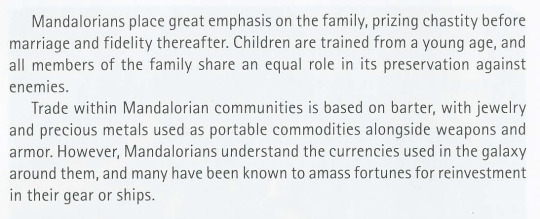
Mandalorians place great emphasis on the family, prizing chastity before marriage and fidelity thereafter. Children are trained from a young age, and all members of the family share an equal role in its preservation against enemies
and The Old Republic Encyclopedia (2012):

CLAN SOCIETY Mandalorian society operates with a minimal and largely informal power structure. Every Mandalorian is a member of a clan, either by birth or recruitment. Although different clans often disagree and even fight one another, they treat their own members like family, regardless of whether they’re related by blood ties or oath. Other than the clan chieftain, members have no official ranks or positions unless organized into a fighting unit where chain of command has a valuable place. Each man or woman is expected to contribute however they can, with those who achieve great things gaining increased respect and new responsibilities. Although clans may have ties or rivalries with other clans, there is no formal hierarchy. All chieftains report directly to the Mandalore The families of Mandalorians are close-knit and remarkably affectionate, despite the culture’s propensity for violence. Marriage is considered a lifelong commitment, and both biological and adopted children are raised with equal love. Sons and daughters are raised as warriors, as gender has little bearing in Mandalorian culture, so much their language hardly distinguishes between male and female.
If the Mandalorians in the twilight of Taung hegemony and relatively shortly after their extinction are presented as those who treat their sons and daughters as equally valued members of the community, then we should ask what caused such discord between this image and the one presented in Mandalorians: People and Culture. If we agree that the term of traditional Mandalorians from mentioned article is not about people from Sith Wars - Mandalorians Wars era and following conflicts but about those between the ancient and modern times, then once again we must determine how much the values of the original Mandalorians have been distorted through the millennia and how trustworthy is our narrator.
As the sources of widely understood lore were examined, let’s look again at the “traditional” afterlife and Mandalorian gods involved with the creation myth. As the article proclaims, “every Mando warrior who dies is said to add to the army of the afterlife”, thus we should assume it includes warriors of all genders. But then the army’s purpose is “defending wives and children living in its permanent, peaceful homestead” yet there is no information against whom the presumably non-combatant inhabitants must be defended. If said army takes part in the eternal conflict between Death and Life, an army of dead wouldn’t then serve Arasuum rather than Kad Ha’rangir, whose connection is to life and change?
There is no explanation why only wives and children are excluded, since children were meant to learn the art of war from their parents, thus logically should join their family in the ongoing battle from age of 8. We should also ask what about professions like blacksmiths or farmers who in life provided vital support for the army by making armors and weapons or producing food. Are they too enrolled into the army of the afterlife if they weren’t nomadic warriors or professional soldiers or allowed to stay in a peaceful homestead? What about those who never could become warriors due to physical or mental illness? Or the same-sex couples with their children? Article described afterlife as the “plane of spiritual energy”, but there is a gender division (women staying in safe homestead), age division (adults and children) and profession division (warriors and non-combatants/mothers/wives), wouldn’t that suggest that Mandalorians at some point believed that afterlife will to some degree mirror their mortal life? If the family bonds stay the same (marriage even in the death and children to take care of), it is not so difficult to imagine the army’s need for armor, weapons, maybe even food and clothes to continue the eternal battle.
Going further with that thought, Arasuum is the one that “remains the same”, while article adds “sloth-god, the personification of idle consumption” and the homestead located in afterlife is described as “permanent” and “peaceful” while the role of Kad Ha’rangir - the Destructor - is definitely much more aggressive in nature. I believe this could reflect the belief that life is a constant battle and struggle that every person at some point will lose, while death is the non-transitory state of existence that offers both a place of peace and an eternal army to join, thus fulfilling the religious purpose Mandalorians dedicated their life to.
Thus Kad Ha’rangir and Arasuum ties to each other may be more complex than we are led to believe because the sense of original mythology either got lost or has changed with Mandalorians over the millenia. Which is why I believe that Arasuum as sloth-god may be an effect of misinterpretation of modern Mandalorians who are disconnected from the original faith of Mandalorian!Taungs as they rejected religious fanaticism and worship of their predecessors.
It won't be an exaggeration to say that the Mandalorians: People and Culture is an important source that both helped popularize modern Mandalorians in star wars fandom during Prequels era and served as an useful introduction to their culture. However, from the perspective of widely understood lore and passing time, this article does not reflect the complexity of Mandalorian culture nor its religion. Arasuum and his opponent, Kad Ha’rangir, is only briefly introduced here but this introduction will influence other authors' take on mandalorian religion.
And those additional tie-in material will be the subject of the next part.
SIDENOTES:
[1] Karen Traviss popularized Mandalorians, however this faction was already expanded by tie-in materials in the past beyond Boba Fett’s character. Other Mandalorian human people for the first time were introduced in Star Wars 68: The Search Begins (1982), while the ancient Mandalorians (Taungs) came to life in The Sith War comics (1995), as part of Tales of the Jedi series. The game Knights of the Old Republic (2003) exploited Mandalorian Wars, and the post-war era, when Taungs died out and their legacy was passed on to the humans. Jaster Mereel’s True Mandalorians and Tor Vizsla’s Death Watch were introduced into lore in 2002, as a way to expand Jango Fett’s backstory for Attack of the Clones film, while the Death Watch name alone has been part of lore since 1989(!). Finally, the Republic Commando book series shaped and popularized the modern Mandalorians (2005-2009), before The Clone Wars animated series (2008-2020) explored the conflict between Death Watch and New Mandalorian, followed by animated TV series Rebels (2014-2018) and Disney made a whole mandalorian-focused TV series (2019-present day).
[2] It is worth keeping in mind that all information about Jaster and Tor’s ideology comes from Count Dooku’s narration. Death Watch has never stated their goals in the comics alone, while Dooku’s opinions were based on information delivered by Jaster & Jango’s allies (including Silas, True Mandalorian tortured by the Sith Lord for information about Jaster’s death). So though Jango Fett: Open Seasons with no doubt is not an objective in its narratives, it gives some credibility to Dooku’s claim about Jaster and True Mandalorians as he sought out Fett's allies in his research about Jango’s past.
[3] dar’manda means a state of not being Mandalorian - a person that is not an outsider, but one who has lost or given up on their heritage, mandalorian identity and the soul.
[4] The dialect was first presented in The Cestus Deception book (2004) as a Mandalorian language but Guide to the Grand Army of the Republic by Karen Traviss and Ryan Kaufman published in Star Wars Insider #84 (september 2005) retconned it as a separate dialect. The “mistake” made in the book is however easy to explain - Sheeka Tull knew Jango Fett personally, after he freed himself from slavery but between he went full into the bounty hunting profession. As she herself was not a Mandalorian and she and Jango met in the Meridian sector, she could mistake Jango’s native language for the mando’a. Fett, as a person born and raised on Concord Dawn could even mix his native language with mando’a. Understandably, Sheeka couldn’t see the difference if she had no other ties to mandalorian culture than one year of dating (post-Galidraan) Jango Fett.
[5] The Behind the Scenes section of wookiepedia’s page for Concordia dialect states that:
At least one Concordian phrase from "The Mandalore Plot"—specifically the line exclaimed by the Death Watch bomber before leaping to his death, and featured as this article's main quote—appears to have been drawn from a 2007 post on the Empire at War forum, in which a user had compiled a list of fanon words and translations for the fledgling Mandalorian language. The aforementioned quote, "Calhava bru'chun dralshye'ran," was translated in the post as "Compassionate leaders will burn." Although the translation would seem contextually appropriate to the episode's storyline, to date there has been no official confirmation that this is the canonically accepted translation.
[6] The part of article focused on language acknowledged the similarity between mando'a and the language of the Taung "from whom the original inhabitations of Mandalore were thought to be descended", yet still does call mando'a origins as unclear.

[7] There is a visible difference between ancient and modern Mandalorians in regard to their dead. Ancient Mandalorians took time to perform proper funeral rites for warriors killed in fight and even have special Death Ceremony for the most brave while modern people have less strict approach. Partially due to the nature of mercenary work (when sometimes the body of fallen comrade could not be brought back to home) and partially due to believing in Manda, in which soul is more important than the body.
[8] The presented idea of Mandalorian fathers training sons may in fact be based on Attack of the Clones Visual Guide (2002) and not be Karen Taviss' own invention. I think the presented informations in her article could be an attempt to keep lore intact. Below the AotC Visual Guide's description for comparison:
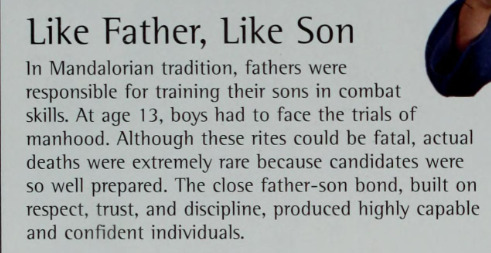
Like Father, Like Son In Mandalorian tradition, fathers were responsible for training their sons in combat skills. At age 13, boys had to face the trials of manhood. Although these rites could be fatal, actual deaths were extremely rare because candidates were so well prepared. The close father-son bond, built on respect, trust, and discipline, produced highly capable and confident individuals.
[9] The presented frame with Ko Sornell's family forgot include the small baby presented in issue #2 (the frames as reference were included in the analysis). Considering the mentioned baby and how the daughter is much smaller than the son at least in the one frame we see the kids close-up,

I think it is safe to assume there were two younger children most likely left under father's care while Ko Sornell was raiding the basilisk droid with her son (and three kids to take care of when Ko was far away for at least few days).
#star wars#cienie's take on mandalorian culture#arasuum#kad ha'rangir#mandalorian culture#mandalorian religion#I’m fully aware that Mandalorians: People and Culture (2006) predates a great number of tie-in material. that expanded our knowledge about#but it was important to establish how outdated the article is from the perspective of time.#i tend to see M:PaC as a good start into basic idea of culture but told from the perspective of modern mandalorians#while the knowledge about ancient times may be misinterpreted by “modern narrator”#also trust me to write a long post and add another wall of sidenotes lol#i know i'm pretty critical to KT's take on gender norms and some aspect of mando culture but the focus on father-son bonds#may be in fact influenced by earlier estabilished informations#but then taungs are pretty much ignored by the author when the religion definitely was affected by taungs
5 notes
·
View notes